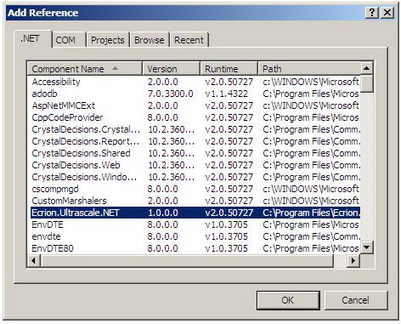|
Writing a Simple .NET Application |




|
Using the Ultrascale .NET API is very easy. Below, the steps that must be followed in order to create a simple "Hello World" application are described.
Step 1: Creating a New Microsoft Visual Studio 2005 Project
First, Visual Studio 2005 must be opened. Then, the user must access File > New > Project... and select Visual C# > Console Application.
Step 2: The Ecrion Ultrascale References must be added

To add a reference, the user must acccess Project > Add Reference... and select Ecrion.Ultrascale.NET from the list (as shown in the screenshot above).
Step 3: Type In The Code
The code listed below must be copied into the Program.cs file. Then, the F5 key must be pressed or the Debug > Run option selected. As a result, a PDF file named "HelloWorld.pdf" will be written in the user's C:\temp folder.
Note:
| · | The user must make sure that the C:\temp folder exists and writing access is granted for the mentioned folder. |
using System;
using System.IO;
using Ecrion.Ultrascale;
namespace HelloWorld
{
class Program
{
[STAThread]
static void Main(string[] args)
{
String outFilePath = @"C:\temp\HelloWorld.pdf";
FileStream outputStream = null;
try
{
//XSL-FO input
String xml = "<fo:root xmlns:fo='http://www.w3.org/1999/XSL/Format'>" +
"<fo:layout-master-set>" +
"<fo:simple-page-master master-name='all-pages'>" +
"<fo:region-body region-name='xsl-region-body' margin='0.7in'/>" +
"</fo:simple-page-master>" +
"</fo:layout-master-set>" +
"<fo:page-sequence master-reference='all-pages'>" +
"<fo:flow flow-name='xsl-region-body'>" +
"<fo:block>Hello World!</fo:block>" +
"</fo:flow>" +
"</fo:page-sequence>" +
"</fo:root>";
// Get bytes of string
byte[] stringBytes = System.Text.Encoding.UTF8.GetBytes(xml);
// Create input stream
Stream inputStream = new MemoryStream(stringBytes);
// Initialize data source
IDataSource input = new XmlDataSource(inputStream, Engine.InputFormat.XSLFO);
// Create output stream
outputStream = new FileStream(outFilePath, FileMode.Create);
// Create parameters for the rendering operation.
RenderingParameters param = new RenderingParameters();
// Set output format
param.OutputFormat = Engine.OutputFormat.PDF;
// Creates print ready documents using Ecrion XF Ultrascale engine
Engine engine = new Engine();
engine.Render(input, outputStream, param);
Console.WriteLine("Document rendered successfully!\n");
}
catch (Exception e)
{
// Report errors
Console.Out.WriteLine(e.Message);
if (e.InnerException != null)
Console.Out.WriteLine(e.InnerException.ToString());
// Close and delete the (partial) output file if any
if (outputStream != null)
{
outputStream.Close();
outputStream = null;
}
if (File.Exists(outFilePath))
File.Delete(outFilePath);
}
}
}
}
This concludes the "Hello World" example. More examples can be found in the Samples folder, that is present after installing XF Rendering Server 2013.
Below, a step by step explanation of the code is available.
Understanding the Code
The engine needs to be passed parameters via a RenderingParameters object. In this example, the most important parameter, which is the output format, is set.
// create parameters for the rendering operation
RenderingParameters param = new RenderingParameters();
// set output format
param.OutputFormat = Engine.OutputFormat.PDF;
The next step is creating the Engine object:
// create a new engine
Engine engine = new Engine();
Next, an input XSL-FO stream is needed. For this example, a MemoryStream constructed from a hard-coded string will be used.
Then, an XmlDataSource object will be utilized to pass it to the engine.
// XSL-FO input
String xml = "<fo:root xmlns:fo='http://www.w3.org/1999/XSL/Format'>" +
"<fo:layout-master-set>" +
"<fo:simple-page-master master-name='all-pages'>" +
"<fo:region-body region-name='xsl-region-body' margin='0.7in'/>" +
"</fo:simple-page-master>" +
"</fo:layout-master-set>" +
"<fo:page-sequence master-reference='all-pages'>" +
"<fo:flow flow-name='xsl-region-body'>" +
"<fo:block>Hello World!</fo:block>" +
"</fo:flow>" +
"</fo:page-sequence>" +
"</fo:root>";
// get string bytes
byte[] stringBytes = System.Text.Encoding.UTF8.GetBytes(xml);
// create input stream from string bytes
Stream inputStream = new MemoryStream(stringBytes);
// Initialize data source
IDataSource input = new XmlDataSource(inputStream, Engine.InputFormat.XSLFO);
Now, an output stream is created (a FileStream is used in the example) to call the Render() method on the Engine object.
// create output stream from file
Stream outputStream = new FileStream("C:\\temp\\HelloWorld.pdf", FileMode.Create);
// render
engine.Render(input, outputStream, param);